Instruction
Why you’re pulling your wedges, and how to stop
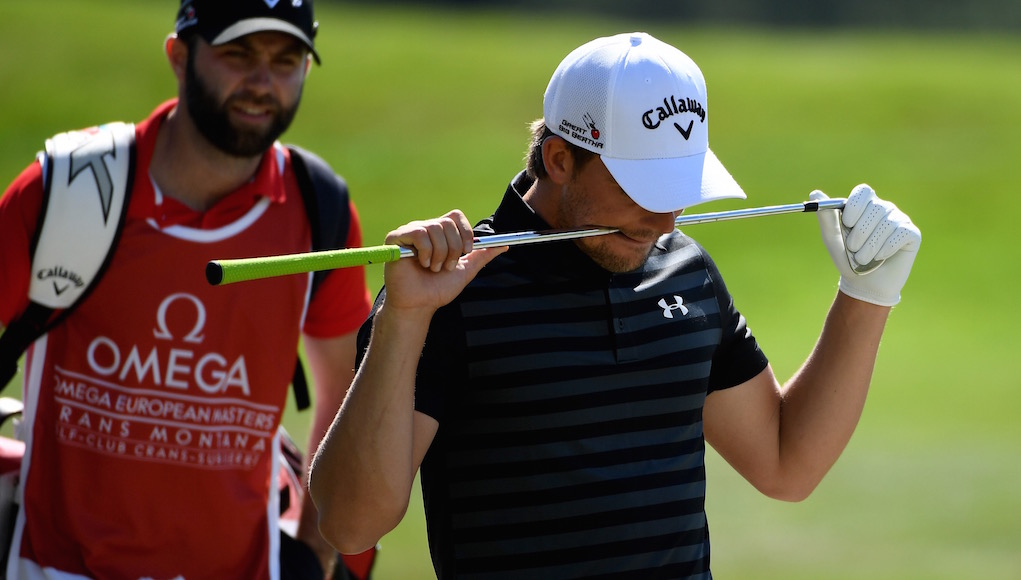
One of the best feelings in golf is to hit a monster drive within wedge range — especially when your buddies have 7-irons in their hands back behind you — so you can actually attack the pin. You take dead aim at the flag, but after you hit your shot you look up and see the ball heading left of the green with its left blinker on. Crap! Your buddies hit the green with a 7-iron, but you just dumped it in the hay with a wedge.
Why does this always happen with your wedges? Why can you never take advantage of your length off the tee? I’m here to tell you why.
In order to hit wedges straight at your target you need to have your club path and your impact face angle moving down the line together at impact (within reason). Now we know there is most always some diversion between the face angle of your club and its path, but if you can make it small and have everything moving towards the pin the ball will fly pretty straight. This is especially true with wedges, which fly straighter than your other clubs because they create higher spin lofts that negate curvature.
Figure 1
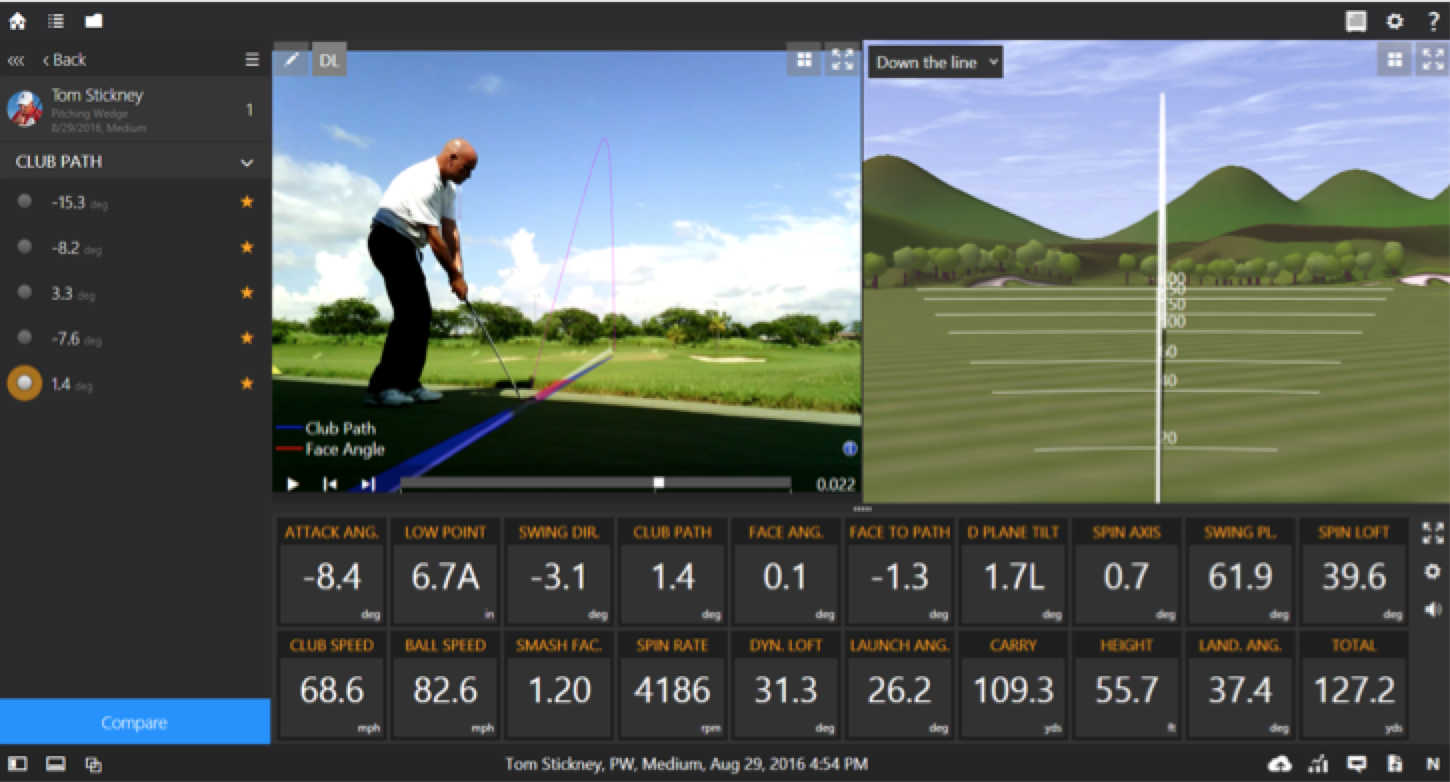
Take a look at Figure 1. The white line in the left window is the target line, the blue line is my path and the red arrow is my impact face angle at impact. See how the path and face are more or less heading toward the target? This is what we want to see in order to hit straight shots with wedges.
Pull with wedges can be due to a few different factors, but the first most common problem is what I call “happy hands” through impact. Happy hands refers to a slowing down of the body’s rotation through impact, causing a flipping or rolling of the hands. That thrusts the face angle left of the club path. In Figure 2, you will notice that the path is from the inside at 3.3 degrees, but the face angle is -3.1 degrees left of the target. For that reason, the shot started a touch left of the target and moved farther left, as you can see in the ball’s curvature screen.
Figure 2
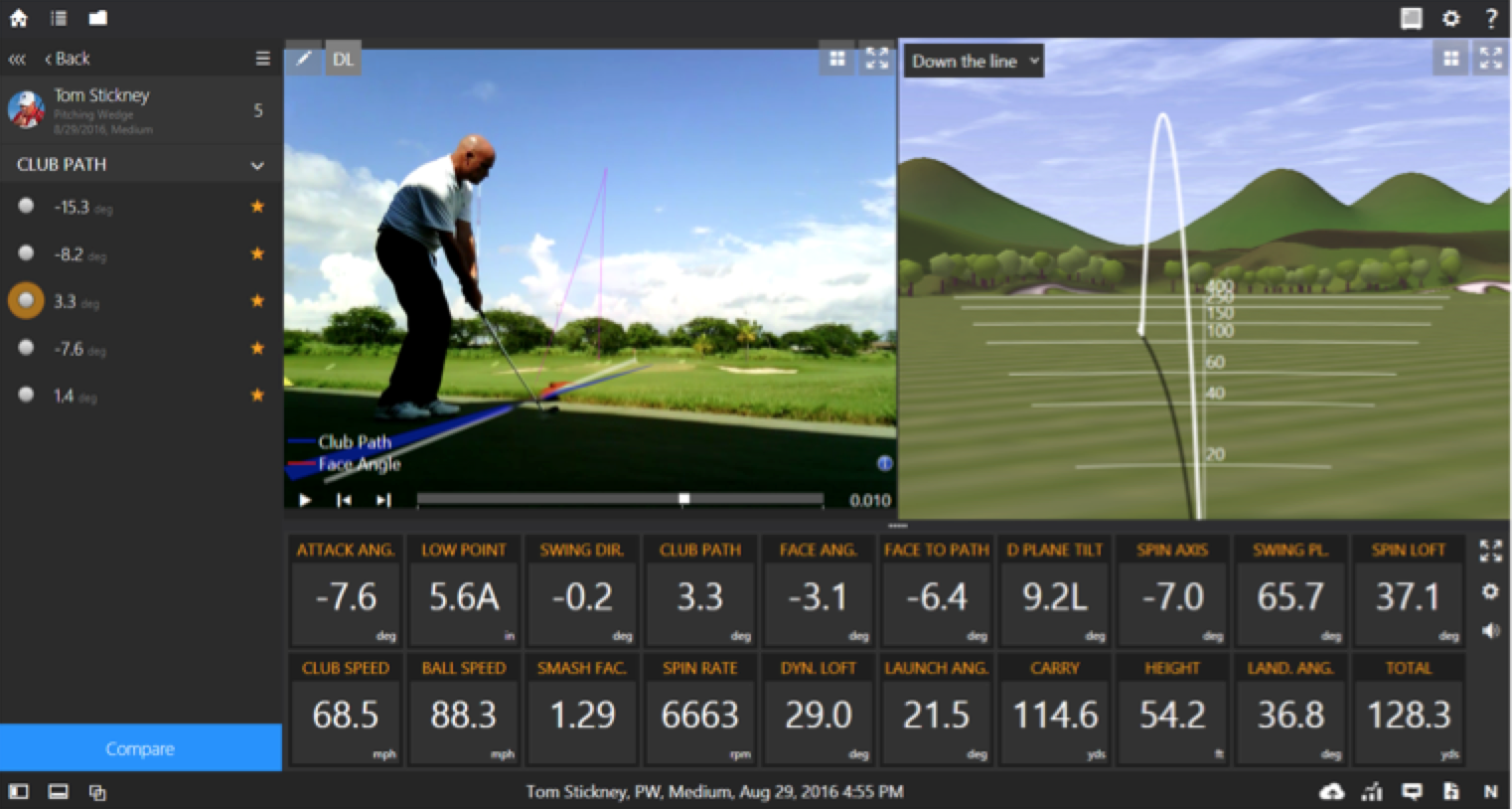
The secret to stopping these pulls is to go to the range and hit shots with head covers under your armpits. This drill makes your body and arms stay more in sync through impact, reducing happy hands. When you body is connected, the hands will work with — not against — the motions of the torso.
A side note about equipment: Wedge pulls can also be caused by wedges that are not fit correctly. If a wedge is too upright, golfers can hit pulls when the heel of the club impacts the ground and flips the blade left… the heel dragger. Standard off-the-rack lie angles for wedges are 64 degrees, but many PGA Tour players use wedges with slightly flatter lie angles to deal with long rough that can shut their club faces through impact. Getting the proper lie angle is just as important as choosing the correct loft and grind, so if you’re serious about your game make sure your wedges are dialed in by a reputable club fitter.
The second type of pull is one born out of a club path and club face that are too far left of the target at impact. As you can in Figure 3, the path and the face are inline, but they are pointed well left of the target. This can be caused by faulty alignments or an over-the-top motion caused from an improper pivot during transition.
In order to stop this type of pull, make sure you swing your wedge like you try to every other club — from the inside, never from out-to-in — unless you are hitting a special shot. I would suggest hitting balls off an uphill, sidehill lie (where the ball is above your feet) in order to gain a better understanding of this transitional feel.
Figure 3
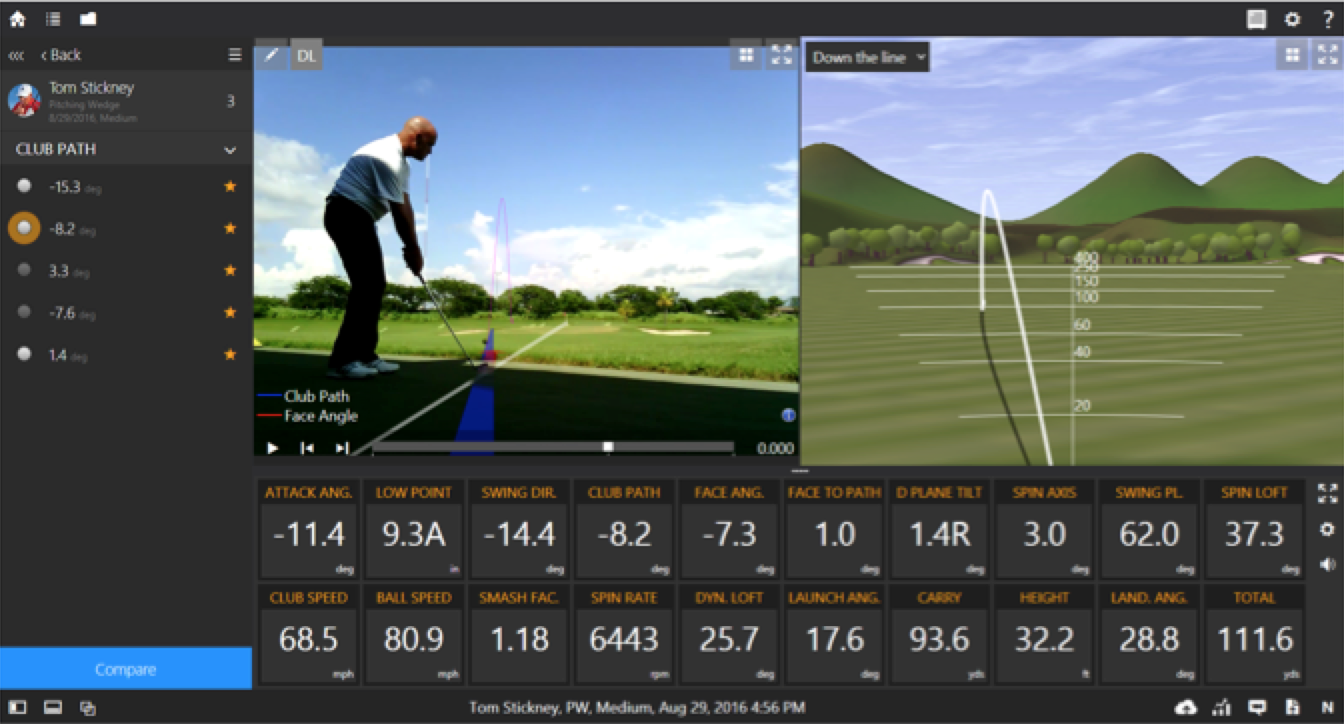
The third and worst type of pull is the over-the-top, happy-handed yank shown in Figure 4. This is caused when your right shoulder starts the downswing and your pivot stalls through impact, allowing the hands to take over. In fact, this type of shot is one that kills beginning and intermediate golfers when the ball is above their feet.
Once again, the secret here is to swing more from the inside and keep the rotation of your body moving to reduce the flipping motion of the hands at the bottom.
Figure 4
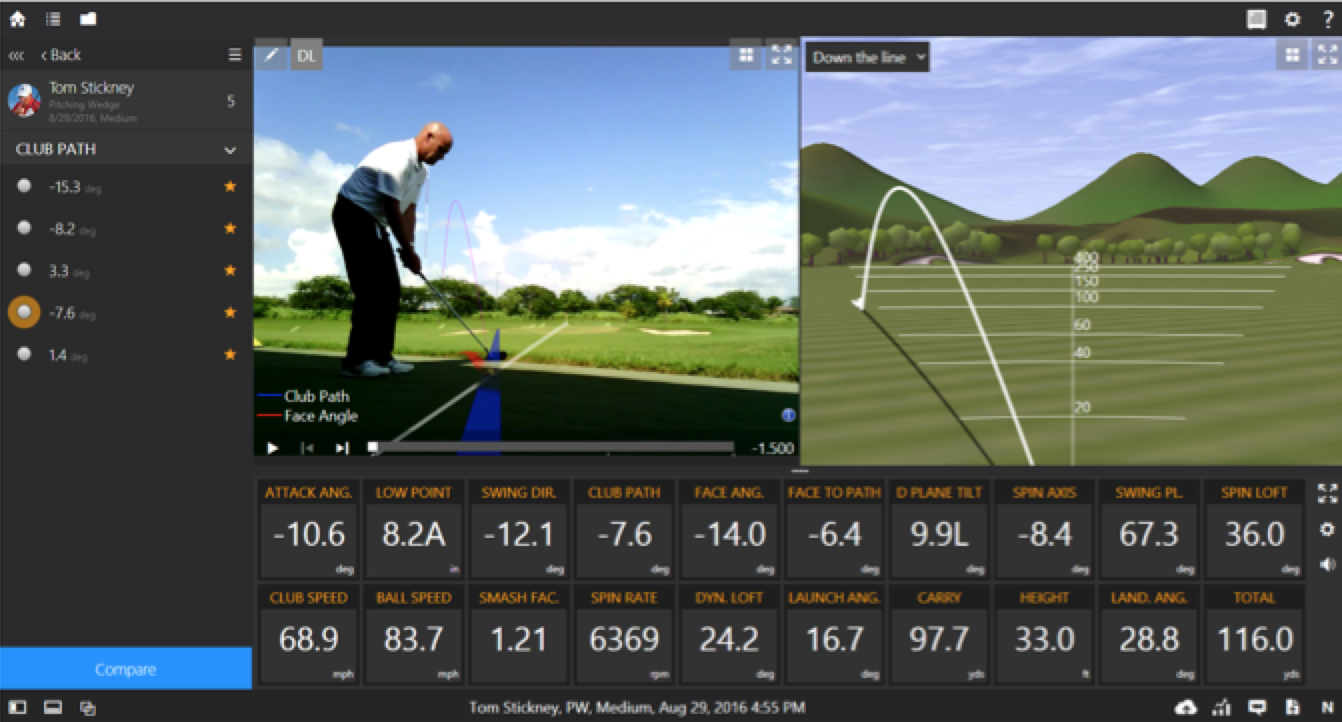
If you’re pulling your wedges, one of these three reasons — or your wedges themselves — are causing the problem. Armed with this knowledge you should be on your way to diagnosing the problem, but I always I recommend seeing a qualified PGA Professional or professional club fitter to help you make the fastest and most sustainable progress.
- LIKE194
- LEGIT23
- WOW6
- LOL4
- IDHT6
- FLOP1
- OB2
- SHANK20
Instruction
The Wedge Guy: The easiest-to-learn golf basic

My golf learning began with this simple fact – if you don’t have a fundamentally sound hold on the golf club, it is practically impossible for your body to execute a fundamentally sound golf swing. I’m still a big believer that the golf swing is much easier to execute if you begin with the proper hold on the club.
As you might imagine, I come into contact with hundreds of golfers of all skill levels. And it is very rare to see a good player with a bad hold on the golf club. There are some exceptions, for sure, but they are very few and very far between, and they typically have beat so many balls with their poor grip that they’ve found a way to work around it.
The reality of biophysics is that the body moves only in certain ways – and the particulars of the way you hold the golf club can totally prevent a sound swing motion that allows the club to release properly through the impact zone. The wonderful thing is that anyone can learn how to put a fundamentally sound hold on the golf club, and you can practice it anywhere your hands are not otherwise engaged, like watching TV or just sitting and relaxing.
Whether you prefer an overlap, interlock or full-finger (not baseball!) grip on the club, the same fundamentals apply. Here are the major grip faults I see most often, in the order of the frequency:
Mis-aligned hands
By this I mean that the palms of the two hands are not parallel to each other. Too many golfers have a weak left hand and strong right, or vice versa. The easiest way to learn how to hold the club with your palms aligned properly is to grip a plain wooden ruler or yardstick. It forces the hands to align properly and shows you how that feels. If you grip and re-grip a yardstick several times, then grip a club, you’ll see that the learning curve is almost immediate.
The position of the grip in the upper/left hand
I also observe many golfers who have the butt of the grip too far into the heel pad of the upper hand (the left hand for right-handed players). It’s amazing how much easier it is to release the club through the ball if even 1/4-1/2″ of the butt is beyond the left heel pad. Try this yourself to see what I mean. Swing the club freely with just your left hand and notice the difference in its release from when you hold it at the end of the grip, versus gripping down even a half inch.
To help you really understand how this works, go to the range and hit shots with your five-iron gripped down a full inch to make the club the same length as your seven-iron. You will probably see an amazing shot shape difference, and likely not see as much distance loss as you would expect.
Too much lower (right) hand on the club
It seems like almost all golfers of 8-10 handicap or higher have the club too far into the palm of the lower hand, because that feels “good” if you are trying to control the path of the clubhead to the ball. But the golf swing is not an effort to hit at the ball – it is a swing of the club. The proper hold on the club has the grip underneath the pad at the base of the fingers. This will likely feel “weak” to you — like you cannot control the club like that. EXACTLY. You should not be trying to control the club with your lower/master hand.
Gripping too tightly
Nearly all golfers hold the club too tightly, which tenses up the forearms and prevents a proper release of the club through impact. In order for the club to move back and through properly, you must feel that the club is controlled by the last three fingers of the upper hand, and the middle two fingers of the lower hand. If you engage your thumbs and forefingers in “holding” the club, the result will almost always be a grip that is too tight. Try this for yourself. Hold the club in your upper hand only, and squeeze firmly with just the last three fingers, with the forefinger and thumb off the club entirely. You have good control, but your forearms are not tense. Then begin to squeeze down with your thumb and forefinger and observe the tensing of the entire forearm. This is the way we are made, so the key to preventing tenseness in the arms is to hold the club very lightly with the “pinchers” — the thumbs and forefingers.
So, those are what I believe are the four fundamentals of a good grip. Anyone can learn them in their home or office very quickly. There is no easier way to improve your ball striking consistency and add distance than giving more attention to the way you hold the golf club.
More from the Wedge Guy
- The Wedge Guy: Golf mastery begins with your wedge game
- The Wedge Guy: Why golf is 20 times harder than brain surgery
- The Wedge Guy: Musings on the golf ball rollback
- LIKE85
- LEGIT13
- WOW6
- LOL1
- IDHT0
- FLOP4
- OB1
- SHANK8
Instruction
Clement: Stop ripping off your swing with this drill!

Not the dreaded headcover under the armpit drill! As if your body is defective and can’t function by itself! Have you seen how incredible the human machine is with all the incredible feats of agility all kinds of athletes are accomplishing? You think your body is so defective (the good Lord is laughing his head off at you) that it needs a headcover tucked under the armpit so you can swing like T-Rex?
- LIKE0
- LEGIT2
- WOW2
- LOL0
- IDHT0
- FLOP0
- OB0
- SHANK2
Instruction
How a towel can fix your golf swing

This is a classic drill that has been used for decades. However, the world of marketed training aids has grown so much during that time that this simple practice has been virtually forgotten. Because why teach people how to play golf using everyday items when you can create and sell a product that reinforces the same thing? Nevertheless, I am here to give you helpful advice without running to the nearest Edwin Watts or adding something to your Amazon cart.
For the “scoring clubs,” having a solid connection between the arms and body during the swing, especially through impact, is paramount to creating long-lasting consistency. And keeping that connection throughout the swing helps rotate the shoulders more to generate more power to help you hit it farther. So, how does this drill work, and what will your game benefit from it? Well, let’s get into it.
Setup
You can use this for basic chip shots up to complete swings. I use this with every club in my bag, up to a 9 or 8-iron. It’s natural to create incrementally more separation between the arms and body as you progress up the set. So doing this with a high iron or a wood is not recommended.
While you set up to hit a ball, simply tuck the towel underneath both armpits. The length of the towel will determine how tight it will be across your chest but don’t make it so loose that it gets in the way of your vision. After both sides are tucked, make some focused swings, keeping both arms firmly connected to the body during the backswing and follow through. (Note: It’s normal to lose connection on your lead arm during your finishing pose.) When you’re ready, put a ball in the way of those swings and get to work.

Get a Better Shoulder Turn
Many of us struggle to have proper shoulder rotation in our golf swing, especially during long layoffs. Making a swing that is all arms and no shoulders is a surefire way to have less control with wedges and less distance with full swings. Notice how I can get in a similar-looking position in both 60° wedge photos. However, one is weak and uncontrollable, while the other is strong and connected. One allows me to use my larger muscles to create my swing, and one doesn’t. The follow-through is another critical point where having a good connection, as well as solid shoulder rotation, is a must. This drill is great for those who tend to have a “chicken wing” form in their lead arm, which happens when it becomes separated from the body through impact.
In full swings, getting your shoulders to rotate in your golf swing is a great way to reinforce proper weight distribution. If your swing is all arms, it’s much harder to get your weight to naturally shift to the inside part of your trail foot in the backswing. Sure, you could make the mistake of “sliding” to get weight on your back foot, but that doesn’t fix the issue. You must turn into your trial leg to generate power. Additionally, look at the difference in separation between my hands and my head in the 8-iron examples. The green picture has more separation and has my hands lower. This will help me lessen my angle of attack and make it easier to hit the inside part of the golf ball, rather than the over-the-top move that the other picture produces.


Stay Better Connected in the Backswing
When you don’t keep everything in your upper body working as one, getting to a good spot at the top of your swing is very hard to do. It would take impeccable timing along with great hand-eye coordination to hit quality shots with any sort of regularity if the arms are working separately from the body.
Notice in the red pictures of both my 60-degree wedge and 8-iron how high my hands are and the fact you can clearly see my shoulder through the gap in my arms. That has happened because the right arm, just above my elbow, has become totally disconnected from my body. That separation causes me to lift my hands as well as lose some of the extension in my left arm. This has been corrected in the green pictures by using this drill to reinforce that connection. It will also make you focus on keeping the lead arm close to your body as well. Because the moment either one loses that relationship, the towel falls.


Conclusion
I have been diligent this year in finding a few drills that target some of the issues that plague my golf game; either by simply forgetting fundamental things or by coming to terms with the faults that have bitten me my whole career. I have found that having a few drills to fall back on to reinforce certain feelings helps me find my game a little easier, and the “towel drill” is most definitely one of them.
- LIKE12
- LEGIT2
- WOW2
- LOL0
- IDHT0
- FLOP2
- OB0
- SHANK8
-

 19th Hole1 week ago
19th Hole1 week agoDave Portnoy places monstrous outright bet for the 2024 Masters
-

 19th Hole2 weeks ago
19th Hole2 weeks agoThings got heated at the Houston Open between Tony Finau and Alejandro Tosti. Here’s why
-

 19th Hole1 week ago
19th Hole1 week agoTiger Woods arrives at 2024 Masters equipped with a putter that may surprise you
-

 19th Hole2 weeks ago
19th Hole2 weeks agoReport: Tiger Woods has ‘eliminated sex’ in preparation for the 2024 Masters
-

 19th Hole3 days ago
19th Hole3 days agoTwo star names reportedly blanked Jon Rahm all week at the Masters
-

 19th Hole2 days ago
19th Hole2 days agoNeal Shipley presser ends in awkward fashion after reporter claims Tiger handed him note on 8th fairway
-

 19th Hole2 weeks ago
19th Hole2 weeks agoAddiction, spinal fusion, and scam artists – Everything Anthony Kim revealed in candid interview with David Feherty
-

 19th Hole2 weeks ago
19th Hole2 weeks agoAnthony Kim says doctors told him that he ‘may not have much time left’ ahead of LIV return

















Eric
Mar 3, 2024 at 9:26 pm
Lead tape helped me. I put a generous amount of lead tape on the toe of the wedge to keep from pulling the ball.
Chris
Sep 9, 2016 at 7:46 pm
Tom
Can “happy hands” with wedges also cause ballooning (gap and sand wedges launching 30-34 degrees) on full shots or is this caused by something else?
Snowman9000
Sep 9, 2016 at 7:10 pm
When the wedge is too upright in the normal ranges of lie angles, it’s not that the heel digs and makes the club turn over. It’s simply that the face points to the pull side. Two degrees upright with a wedge will make a noticeable difference to the pull side.
kloyd0306
Sep 10, 2016 at 5:06 am
Absolutely correct but the biggest surprise is that Stickney doesn’t know this. He, along with many who also don’t know, need to visit Ralph Maltby’s brilliant explanation on You Tube.
ron
Sep 9, 2016 at 4:59 pm
I bought one of those magnetic things to stick on your club face to show where the face is aiming, and realized that what looked square at address was actually aimed way to the left. Now I set up with a face that’s “looks” slightly open= No more pull shots.
emerson boozer
Sep 14, 2016 at 3:56 am
i need to get me one of those. good idea.